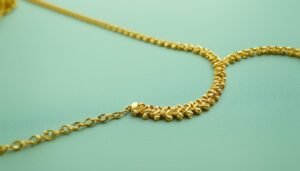When it comes to your precious 14K gold jewelry, understanding care and maintenance is key to preserving its beauty and value.
As you curate your collection, it’s essential to know about tarnish-resistant gold and how to secure the durability of your gold alloy treasures.
While many believe that all gold jewelry is impermeable to tarnish, it’s the blend and the care that dictates the resilience of your 14K gold pieces.
Jewelers often recommend specific routines for jewelry maintenance to ensure your items retain their allure over time.
Key Takeaways
- Understanding the specifics of 14K gold helps in effective jewelry maintenance.
- Regular cleaning is an integral part of 14K gold jewelry care.
- Environmental factors and personal care products can impact gold alloy durability.
- Storing your 14K gold pieces properly can extend their tarnish-resistant qualities.
- Learning about the composition of 14K gold is valuable in preventing premature tarnishing.
Understanding the Composition of 14K Gold
Delving into the essence of 14K gold reveals its unique blend, which strikes a perfect balance between gold purity and practical durability. This cherished metal is not merely a symbol of luxury; its composition makes it a sturdy contender in the realm of jewelry materials. When you grasp the details of 14K gold composition, you’ll appreciate why it has become a staple in jewelry design.
Characterized by a purity of 58.3%, 14K gold is infused with other robust metals, which fortify it against the rigors of everyday wear. The gold-copper alloy aspect particularly introduces a resilience that pure gold lacks, while silver and zinc add their own benefits, enhancing the overall hardiness of the material.
Understanding the precise makeup of 14K gold is essential for both jewelers and enthusiasts alike. Below is a detailed breakdown of its composition:
| Component | Percentage | Role in Alloy |
|---|---|---|
| Pure Gold | 58.3% | Provides the rich color and core value. |
| Copper | Varies | Enhances malleability and contributes to gold’s reddish color. |
| Silver | Varies | Adds strength and affects color hue. |
| Zinc | Varies | Increases durability and contributes to tarnish resistance. |
Each metal added to the core of pure gold plays a crucial role in crafting a robust end product. Not only do these metals alter the physical properties, but they also contribute subtly to the color nuances of 14K gold. It’s this meticulous combination that enables 14K gold to resist wear and tear, signifying a union of beauty and strength ideal for creating diverse and long-lasting jewelry materials.
Why Gold is Resistant to Tarnishing
Exploring the pure gold qualities of 24K gold reveals why it exhibits exceptional tarnish resistance. Unlike most metals, gold is a non-reactive element, which means it does not easily oxidize or corrode when it comes into contact with oxygen or moisture. Because of this inertness, gold retains its lustrous appearance over time, making it highly prized in jewelry making.
However, pure 24K gold, although it maintains its shine indefinitely, is not practical for daily wear. It is often alloyed with other metals to enhance its durability. The addition of these metals also means that lower karat gold, such as 14K, will have a greater tendency to react with environmental elements compared to pure gold.
Despite this, it’s important to understand that 24K gold properties contribute to the overall resistance to tarnishing in mixed gold alloys.
| Gold Type | Purity | Hardness | Tarnish Resistance |
|---|---|---|---|
| 24K Gold | 99.9% Pure | Soft | Does not tarnish |
| 18K Gold | 75% Pure | Harder than 24K | Highly tarnish-resistant |
| 14K Gold | 58.3% Pure | Harder than 18K | Resistant to tarnishing, but may occur over time |
When you’re considering a gold purchase, remember that the pure gold qualities are present to varying degrees in different karat ratings. Knowing the inherent non-reactive elements within the gold you choose will help you understand how it will interact with the world around it, keeping its pure, radiant sheen for generations.
Does 14K Gold Tarnish?
When investing in gold jewelry, understanding the nuances between 14K vs. 24K gold is crucial, particularly concerning how each responds to environmental exposures that might lead to tarnishing. As we delve into the heart of gold jewelry care, it’s imperative to recognize the influence of alloy reactions and the specific tarnishing factors that could affect your treasured pieces.
Comparing 14K Gold to Pure Gold
Gold’s purity is measured in karats, with 24K representing pure gold. However, pure gold is soft and impractical for daily wear. This is where 14K gold, an alloy containing 58.3% pure gold, comes into play. It’s crafted with a blend of metals that enhance its durability and withstand daily activities, making it a favored choice for jewelry.
But how does this lower karat gold stand up against the test of tarnishing? The answer lies in the very alloys that make 14K gold more practical for jewelry.
What Causes Changes in 14K Gold’s Appearance
A pristine piece of 14K gold jewelry can gradually lose some of its glow over time, and pinpointing the exact tarnishing factors becomes a must for any gold aficionado.
Factors such as the oxidation of alloy metals within the 14K gold, particularly silver and copper, can lead to subtle yet visible changes. Furthermore, everyday items like lotions and perfumes can leave behind residues that dull the shimmer of your gold jewelry.
The Role of Alloys in Gold Tarnishing
The distinct composition of 14K gold, featuring a mix of metals, makes it more susceptible to alloy reactions with elements like oxygen and sulfur, especially when exposed to moisture. These interactions can lead to a change in color and brilliance.
Yet despite this susceptibility, 14K gold is less likely to tarnish compared to its lower karat counterparts, due to the reduced percentage of reactive alloys. Proper gold jewelry care is quintessential to minimize these effects and maintain your jewelry’s allure.
| 24K Gold | 14K Gold |
|---|---|
| 100% pure gold | 58.3% pure gold, mixed with other metals |
| Too soft for most jewelry | Ideal balance of durability and luster |
| Does not tarnish | May show signs of tarnishing over time due to alloy reactions |
| Not practical for everyday wear | Designed for daily use with proper care |

Common Misconceptions About Gold Tarnishing
When it comes to genuine gold care, certain gold tarnish myths persist, clouding the judgment of many jewelry owners. One popular belief is that real gold should never tarnish, but this is jewelry misinformation. The truth is a little more complex and rooted in the science of metallurgy.
Let’s dispel some common misconceptions:
- **Pure gold is immune to tarnishing** – While pure 24K gold is less likely to tarnish, it is too soft for practical use in most jewelry.
- **All tarnishing indicates fake gold** – Tarnishing can occur on genuine gold due to the other metals mixed with it.
- **Only low-quality gold tarnishes** – Even high-karat gold can develop a tarnished look under certain harsh conditions.
Gold’s resistance to tarnish is largely due to its noble metal status, meaning it does not react easily with other elements. However, when alloyed with metals like copper or silver to enhance its practicality, the susceptibility to tarnish increases.
This doesn’t reflect poorly on the quality or authenticity of your gold jewelry; it’s simply a natural process that can occur based on environmental factors and lifestyle.
Remember, tarnishing does not devalue or define the realness of your gold; it highlights the need for proper care and regular cleaning.
| Tarnish Myth | Reality |
|---|---|
| Pure gold cannot tarnish | Gold alloys might tarnish due to base metals |
| Tarnishing means the gold is not real | Even genuine gold can tarnish under certain conditions |
| Only poor-quality gold will tarnish | All gold jewelry requires maintenance to prevent tarnish |
Understanding these facts about tarnishing is vital for properly maintaining your precious jewelry. Whether you’re dealing with heirloom pieces or new additions to your collection, knowing how to care for genuine gold will ensure its luster lasts for generations to come.
External Factors Affecting Your Gold Jewelry’s Shine
Every cherished piece of gold jewelry in your collection reflects a part of your personal story, but common external elements may be dimming the sparkle you treasure.
Crafting an effective gold care routine means understanding the culprits behind the loss of luster and taking proactive measures to protect your pieces.

How Everyday Substances Can Dull Gold
Your daily activities can expose your jewelry to various jewelry dulling agents. Something as simple as applying lotion or spraying your favorite perfume may leave a film on gold surfaces, hindering its shine over time. Chlorinated water from pools and cleaning products can react with gold, initiating a process that leads to a dulled appearance.
The Impact of Environmental Elements
Environmental tarnishing is a reality for all precious metals. Gold is remarkably resilient; however, it’s not immune to the effects of air pollution and high humidity levels. These factors can accelerate the tarnishing process, making your jewelry appear less vibrant.
Understanding Body Chemistry’s Role
Each person has a unique personal body chemistry, which can significantly influence how gold reacts while worn. Sweat contains acids and oils, which may cause some individuals’ gold jewelry to lose its luster more quickly than others. It’s a delicate balance, as your personal pH levels and diet can modify the rate at which your jewelry tarnishes.
| Dulling Agent | Source | Preventive Measure |
|---|---|---|
| Perfumes and Lotions | Personal Care Products | Apply before wearing jewelry |
| Chlorine | Pools, Cleaning Agents | Remove jewelry before swimming or cleaning |
| High Humidity | Climate Conditions | Store in a dry environment |
| Body Sweat | Personal Body Chemistry | Clean jewelry after wearing |
| Air Pollutants | Environmental Factors | Regular polishing and cleaning |
Understanding these factors that lead to tarnishing is pivotal in maintaining your gold jewelry’s inherent shine. By integrating preventive measures into your regular care routine, you can ensure your gold remains as luminous as your memories for years to come.
Care and Preservation of 14K Gold Jewelry
Taking care of your 14K gold jewelry involves more than just a quick polish; it requires a dedicated routine to ensure longevity and brilliance. Proper techniques in cleaning, avoiding damaging agents, and optimal storage play a pivotal role in maintaining the jewelry’s intrinsic value and sparkling appearance.
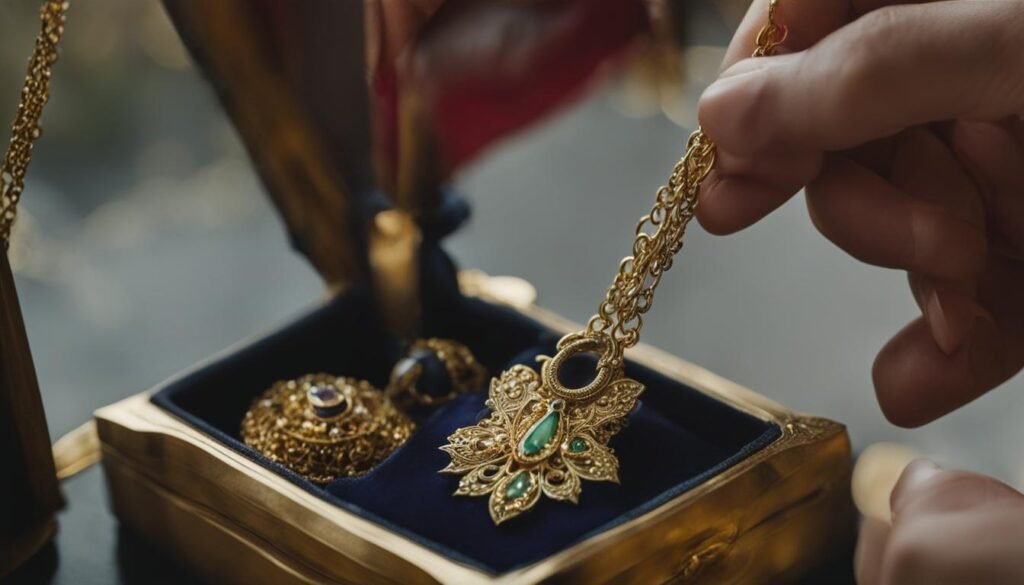
The Importance of Regular Cleaning
To mitigate the risk of tarnish and maintain the splendor of your gold pieces, adhere to these jewelry maintenance tips:
- Utilize a mild soap solution for cleaning, steering clear of abrasive materials.
- Gently use a soft-bristled brush to dislodge any built-up residues.
- Rinse thoroughly with lukewarm water and dry with a soft, lint-free cloth.
Regularly scheduled cleanings can be the difference between dim and luminous 14K gold, preventing gold tarnish and ensuring your jewelry remains a vibrant accessory for all occasions.
Avoiding Harmful Chemical Exposures
Preventive measures against harsh chemicals are crucial for ensuring the longevity of your jewelry’s finish.
- Be mindful of the exposure to chlorine, found in pools and some household cleaners, as it can weaken your jewelry’s integrity.
- Apply cosmetics and perfumes before adorning your gold to minimize contact with potentially tarnishing substances.
Such attentiveness to environmental and chemical exposures represents a proactive approach to preserving the pristine condition of your 14K gold ornaments.
Best Practices for Storing Gold Jewelry
When your jewelry is not adorning you, consider these secure gold storage tips:
| Storage Tip | Benefit | Additional Advice |
|---|---|---|
| Individual Packing | Prevents scratches | Soft pouches or separate compartments in a jewelry box |
| Cool, Dry Place | Reduced risk of tarnish | Avoid areas prone to humidity fluctuations |
| Silica Gel Packets | Absorbs moisture | Include these in your jewelry box to safeguard against tarnish |
By following these steps, you’ll ensure your 14K gold jewelry is preserved, creating a treasure trove of glistening pieces ready to complement any occasion, at any given moment.
Professional Tips for Dealing with Tarnish on Gold
Discovering tarnish on your cherished gold pieces can be disheartening, but fret not, as expert jewelry care is within reach. Heeding professional jeweler advice is essential before attempting any form of gold tarnish removal. A seasoned jeweler will evaluate the extent of tarnish and recommend a tailored cleaning plan to ensure the safe restoration of your gold jewelry’s brilliance.
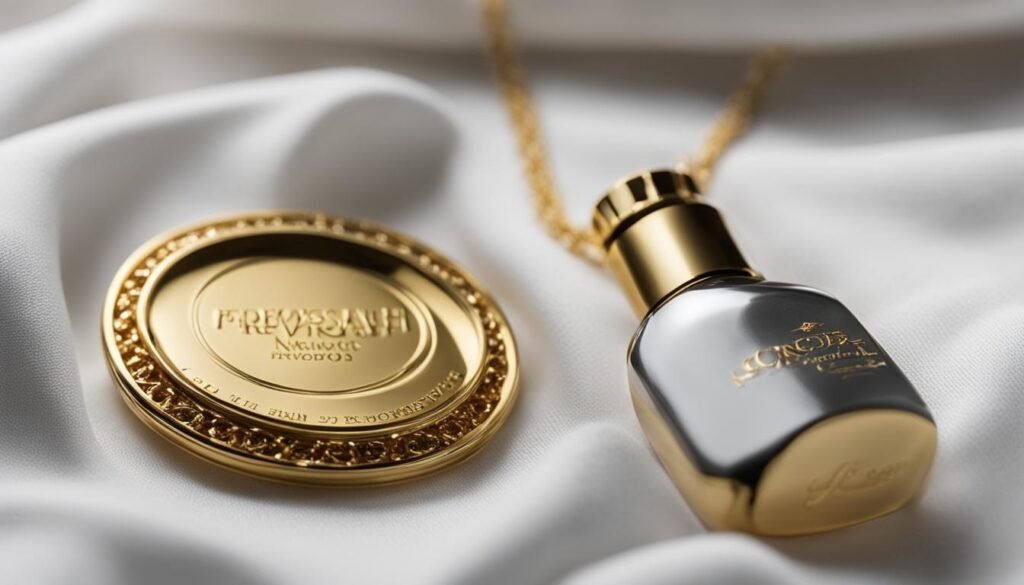
- Initial Inspection – Jewelers will first inspect your gold for any signs of damage that could affect the cleaning process.
- Gentle Cleansing – A soft cloth, mild soap, and warm water are typically used to lift dirt and oils from the gold surface gently.
- Specialized Solutions – If needed, professionals might use ultrasonic cleaners or specific tarnish-removal solutions suitable for gold jewelry.
- Polishing – To finish, a professional-grade polish is applied to enhance the shine and provide a protective barrier against further tarnish.
“Restoration of your gold’s shine is best left in the hands of a reputable jeweler, who will use proven techniques to bring back its original luster without risking harm to your precious items.”
In the event of noticeable tarnish, restrain from using DIY methods that involve harsh chemicals or abrasive techniques that may do more harm than good. The value of professional jeweler advice cannot be overstated; they not only provide gold tarnish removal services but can also impart valuable knowledge on expert jewelry care to prolong the beauty of your gold treasures.
Treating Tarnished Gold: DIY Solutions
When your cherished gold jewelry loses its gleam, don’t despair—simple and safe DIY gold cleaning methods are at your fingertips. Perfecting your gold jewelry upkeep doesn’t require expensive products; often, a homemade concoction works wonders for tarnished treasures. Before you start your restoration journey, ensure you have the right mild cleaning agents to protect your precious items from damage.
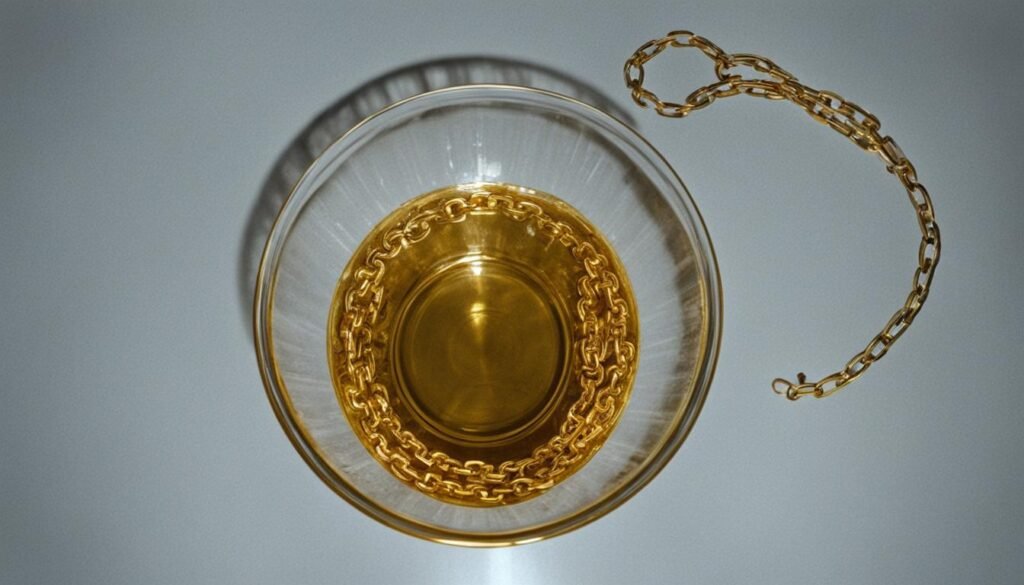
Homemade Cleaning Solutions for Gold
You can create a gentle cleaning solution in your own kitchen that’s effective against grime and surface tarnish. A mixture of a few drops of non-phosphate dishwashing liquid and a bowl of warm water creates a mild, yet efficient, cleaning bath for your gold jewelry. Submerge the jewelry for several minutes, then use your fingers or a soft cotton swab to rub away any tarnish. Here’s a quick recipe to help you maintain the radiance of your gold without harsh chemicals:
| Ingredient | Amount | Function |
|---|---|---|
| Warm Water | 1 cup | Base for cleaning solution |
| Non-Phosphate Dishwashing Liquid | A few drops | Acts as a mild surfactant to loosen tarnish |
Safe Methods for Polishing 14K Gold
A crucial step in gold jewelry upkeep is the polishing phase, which can bring back the shine your gold jewelry once had. After the initial cleaning and drying processes, grab a gold polishing cloth designed specifically for fine jewelry. Use soft, circular motions to buff the surface, gently coaxing the luster back to life—this is one of the safest gold polishing techniques you can perform at home. Here’s a brief guide for polishing your 14K gold pieces:
- Carefully dry your gold jewelry with a soft cotton cloth after cleaning.
- Choose a polishing cloth that’s intended for gold; this ensures it’s soft enough to not scratch the surface.
- Buff gently in circular motions until the original shine is restored.
- Limit polishing to occasionally, as over-polishing can wear down gold over time.
Embracing these easy-to-follow DIY gold cleaning and gold jewelry upkeep techniques ensures that your precious items will continue to sparkle and catch the eye, just like the first day you wore them.
The Lifespan of 14K Gold Jewelry’s Luster
When you invest in gold jewelry, understanding how to maintain its allure is crucial for gold jewelry longevity. Consistency in durable jewelry care and informed practices in maintaining gold sheen is what keeps your 14K gold looking as lustrous as the day you bought it. Let’s explore how you can extend the vibrant life of your precious pieces.
Gold’s timeless appeal lies in its lasting beauty, but like all precious things, it requires a level of upkeep. The care and storage you provide for your 14K gold jewelry play a central role in its longevity. By adhering to a few key practices, you can prevent unnecessary wear and safeguard against the environmental factors that threaten to diminish its sheen.
- Clean your gold jewelry with a soft, lint-free cloth after each wear to remove oils and residues.
- Store your pieces in individual soft pouches or lined jewelry boxes to avoid scratches.
- Keep your gold away from harsh chemicals including chlorine, bleach, and saltwater.
- Consider removing your gold jewelry before engaging in activities that can lead to scratches or impacts.
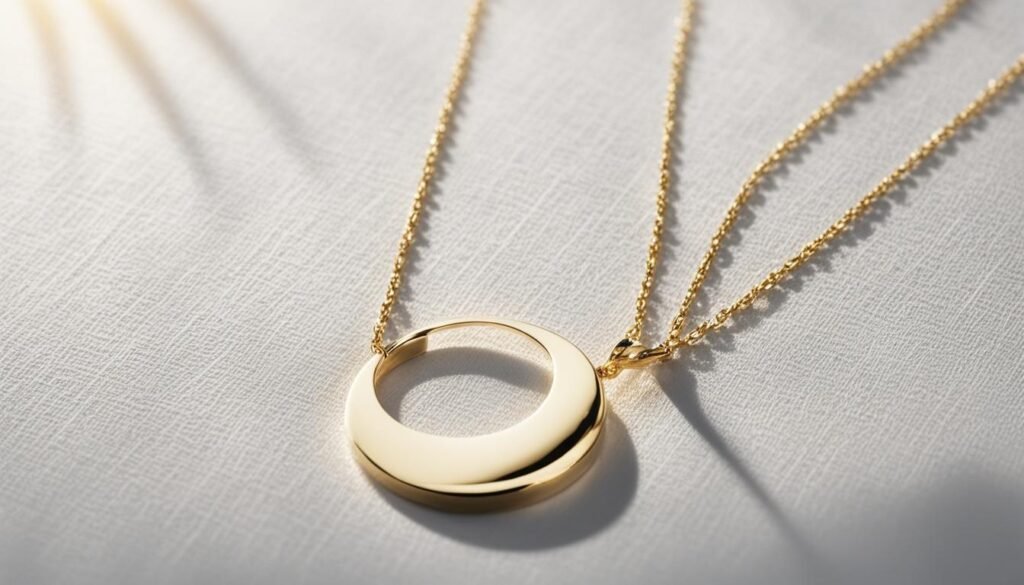
Below is a table that outlines the key factors that affect your gold’s luster and the best practices to counteract them, ensuring you can enjoy your gold jewelry’s radiance for years to come.
| Factors Affecting Gold Luster | Best Practices for Maintaining Sheen |
|---|---|
| Exposure to Chemicals | Avoid contact with cleaning agents and beauty products. |
| Physical Abrasion | Remove during physical labor or exercise. |
| Improper Storage | Use anti-tarnish cloth wraps or boxes when storing. |
| Environmental Factors | Keep away from extreme humidity and heat sources. |
It is evident that the steps you take today to care for your 14K gold will significantly influence its enduring charm. Although it is naturally a strong and long-lasting metal, your attention to durable jewelry care will ensure that its brightness and beauty continue to shine through, making every moment it adorns you feel as special as the first.
Conclusion
Delving into the heart of curated jewelry care, we discover that while 14K gold bears an intrinsic resistance to tarnishing, it does not render it entirely impervious to the subtle shifts in sheen brought on by time and exposure. A vigilant eye and a soft touch in maintenance are the tools at your disposal for 14K gold preservation, safeguarding against the natural tarnish that befalls less noble metals. The reality lies in a simple truth: real gold, including your cherished 14K pieces, demands consistent stewardship to maintain that lasting gold shine that captivates and inspires.
Turning theory into practice necessitates a routine steeped in gentle cleaning with appropriate solutions, a steadfast avoidance of damaging chemicals, and a strategic approach to the placement of each treasured item within your collection.
This triad of actions coalesces into an effective defense, nurturing the radiance that embodies quality and luxury. And while environmental factors and the unseen hand of oxidation beckon with the promise of change, these conscientious steps in jewelry care are your bulwark against the tide, ensuring each piece resonates with the glow it possessed at its inception.
In essence, embracing the rituals that comprise tailored jewelry maintenance serves not merely as a means to an end but as an affirmation of value—both of the splendid adornments you possess and of the care you lavish upon them.
For the owner who savors heritage and cherishes luster, heeding these principles is the pathway to a brilliance that endures.
Let the continuous gleam of your 14K gold pieces be a testament to your dedication to their gleaming legacy.
FAQ About Does 14K Gold Tarnish
Does 14K gold tarnish over time?
While 14K gold is tarnish-resistant, it can undergo subtle changes in appearance due to the oxidation of alloy metals within it or exposure to environmental elements and chemicals.
What is the difference in tarnishing between 14K gold and pure gold?
Pure gold, known as 24K gold, is highly resistant to tarnish because it does not readily react with oxygen and other elements. 14K gold contains alloy metals such as copper and silver, which may oxidize and cause tarnishing under certain conditions, although at a slower rate compared to less pure gold forms.
How can I prevent my 14K gold jewelry from tarnishing?
Regular cleaning with mild soap and water, avoiding harsh chemicals, and proper storage can prevent tarnishing. Keep your 14K gold jewelry away from substances like perfumes and chlorinated water, and store it in a cool, dry place to maintain its luster.
What causes changes in the appearance of 14K gold jewelry?
Changes in 14K gold’s appearance can result from reactions between alloy metals and environmental factors like oxygen, sulfur, and moisture, as well as from contact with cosmetics, lotions, and pollutants.
How should I clean my 14K gold jewelry?
It’s best to use a solution of warm water and mild, non-phosphate dishwashing liquid. Gently brush the jewelry with a soft-bristled brush, rinse thoroughly, and pat dry with a soft cloth.
Can body chemistry affect the tarnishing of 14K gold?
Yes, individual body chemistry can influence how quickly and to what degree gold tarnishes. Factors such as sweat acidity and the presence of certain substances on your skin can accelerate the tarnishing process.
What are the best practices for storing 14K gold jewelry to maintain its shine?
Store your 14K gold jewelry individually to prevent scratches and reduce air exposure. Keep it in a cool, dry place, ideally with silica packets to absorb moisture. Avoid storing jewelry in the bathroom due to humidity.
Is it necessary to consult a professional jeweler when dealing with tarnished 14K gold jewelry?
For significant tarnishing or when in doubt about the proper cleaning method, consulting a professional jeweler is advisable. They can provide expert care and advice to safely restore the luster of your jewelry.
What should I avoid using when cleaning my 14K gold jewelry?
You should avoid using harsh, abrasive materials like toothpaste or baking soda. These can scratch the surface of your gold jewelry. Also, avoid cleaning agents containing chlorine or other harsh chemicals that may damage the metal.
How does the durability of a 14K gold alloy affect the longevity of jewelry’s luster?
The durable nature of the 14K gold alloy, being harder than higher karat gold, helps maintain the jewelry’s luster for a longer period when properly cared for, despite the metal’s exposure to daily wear and environmental factors.




